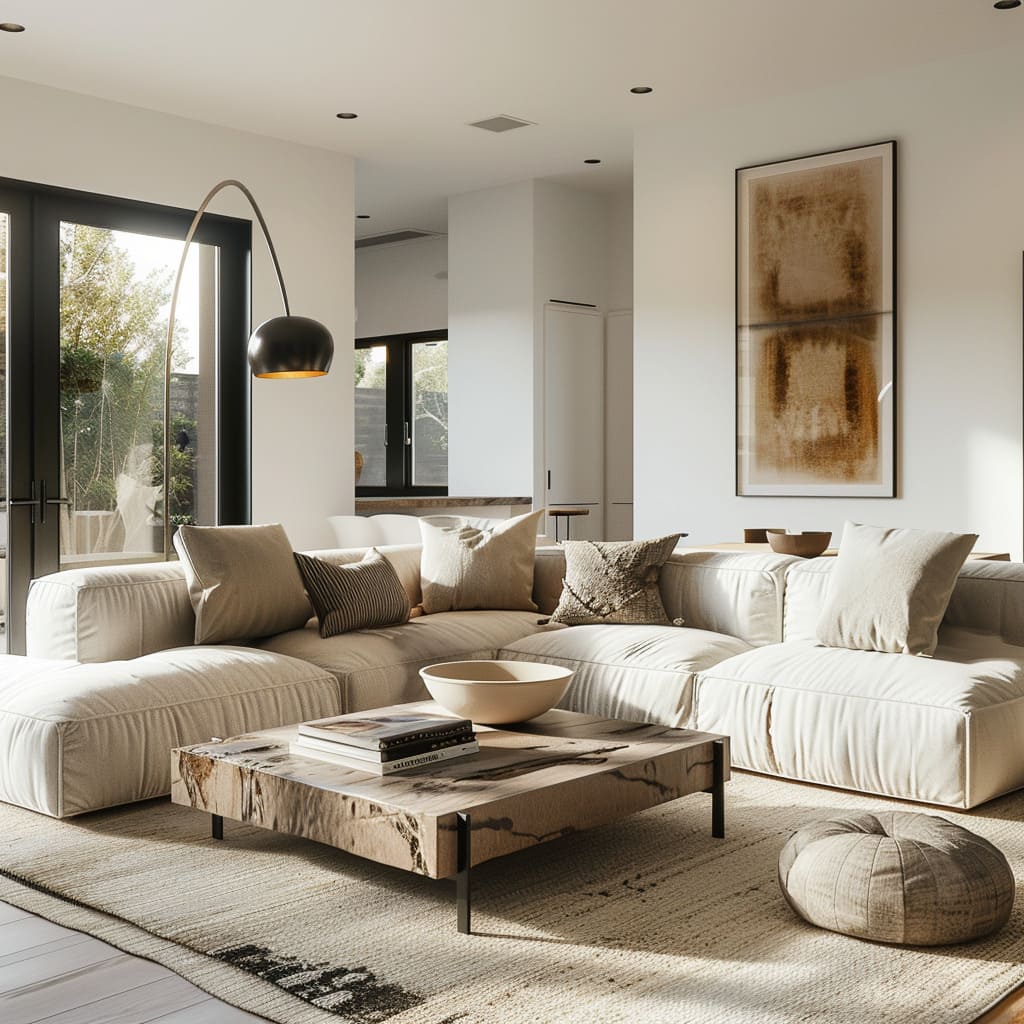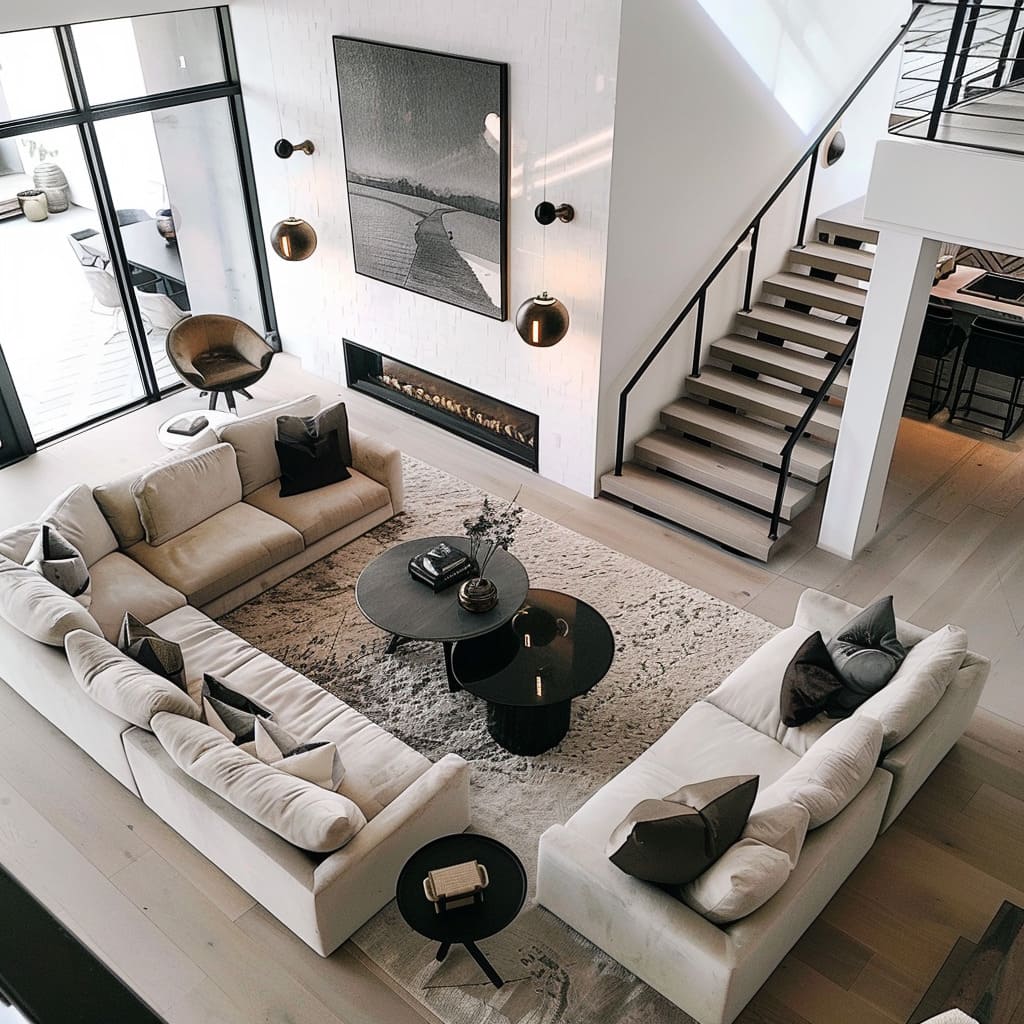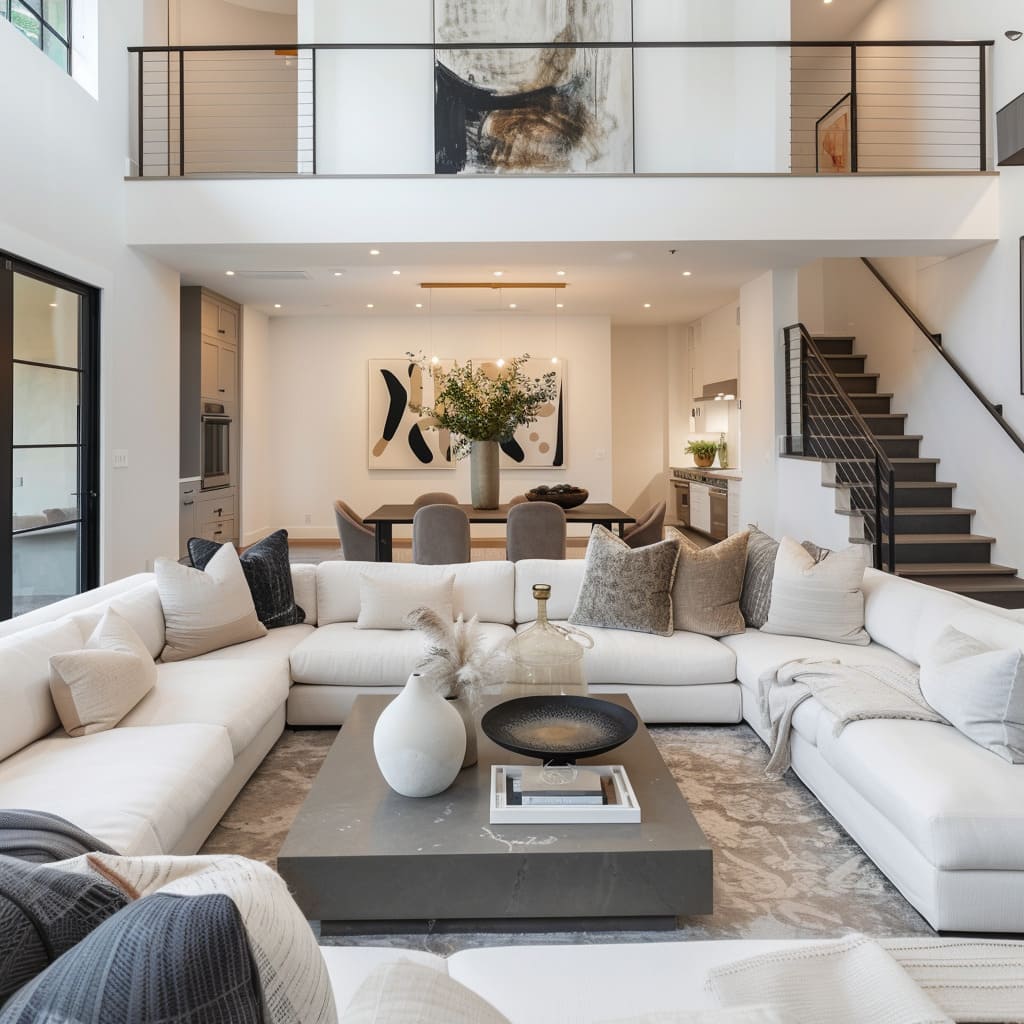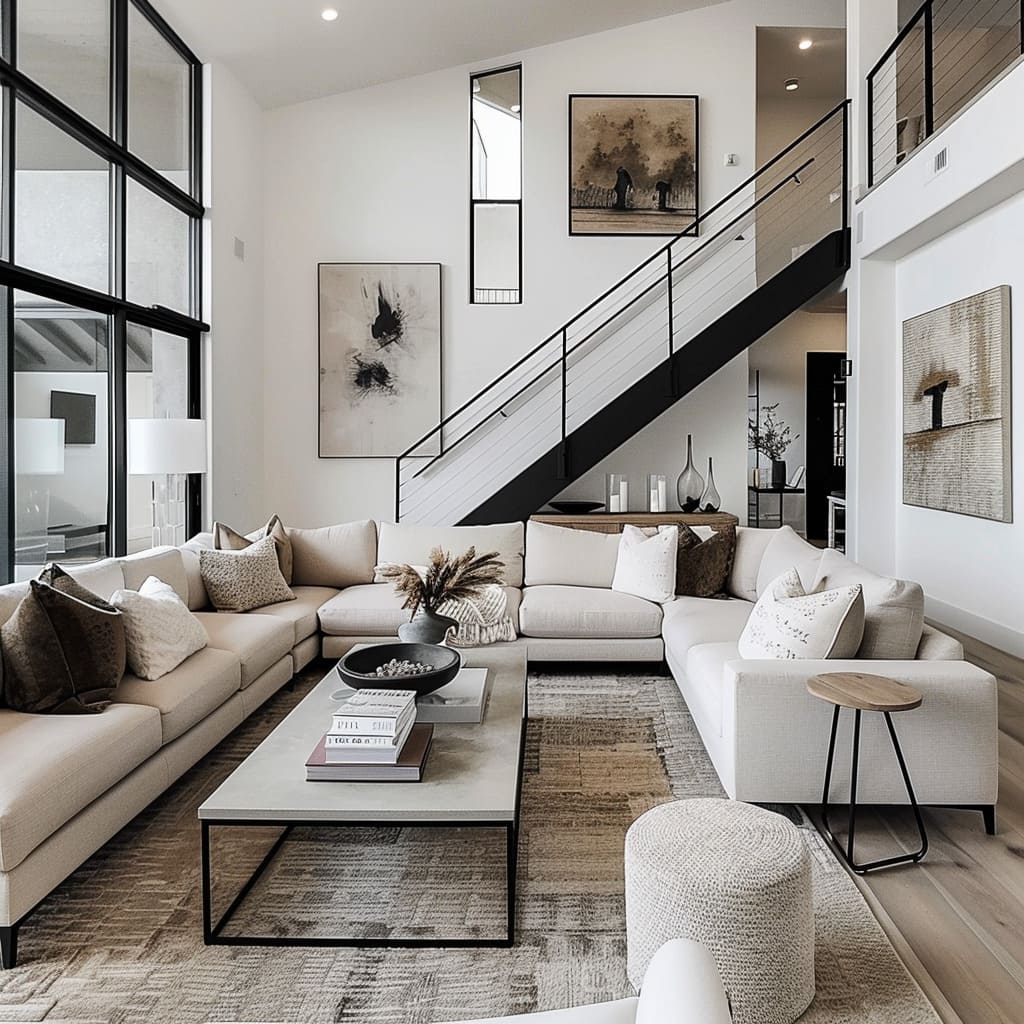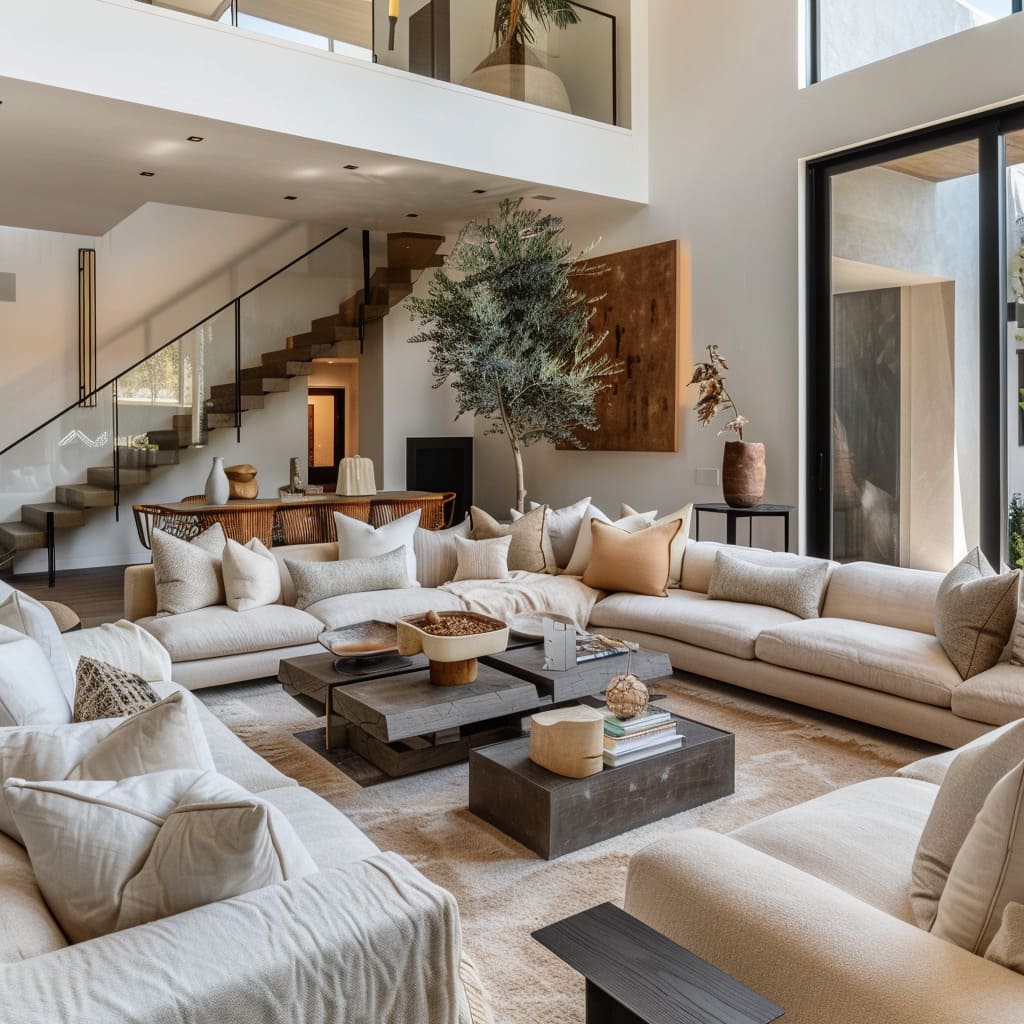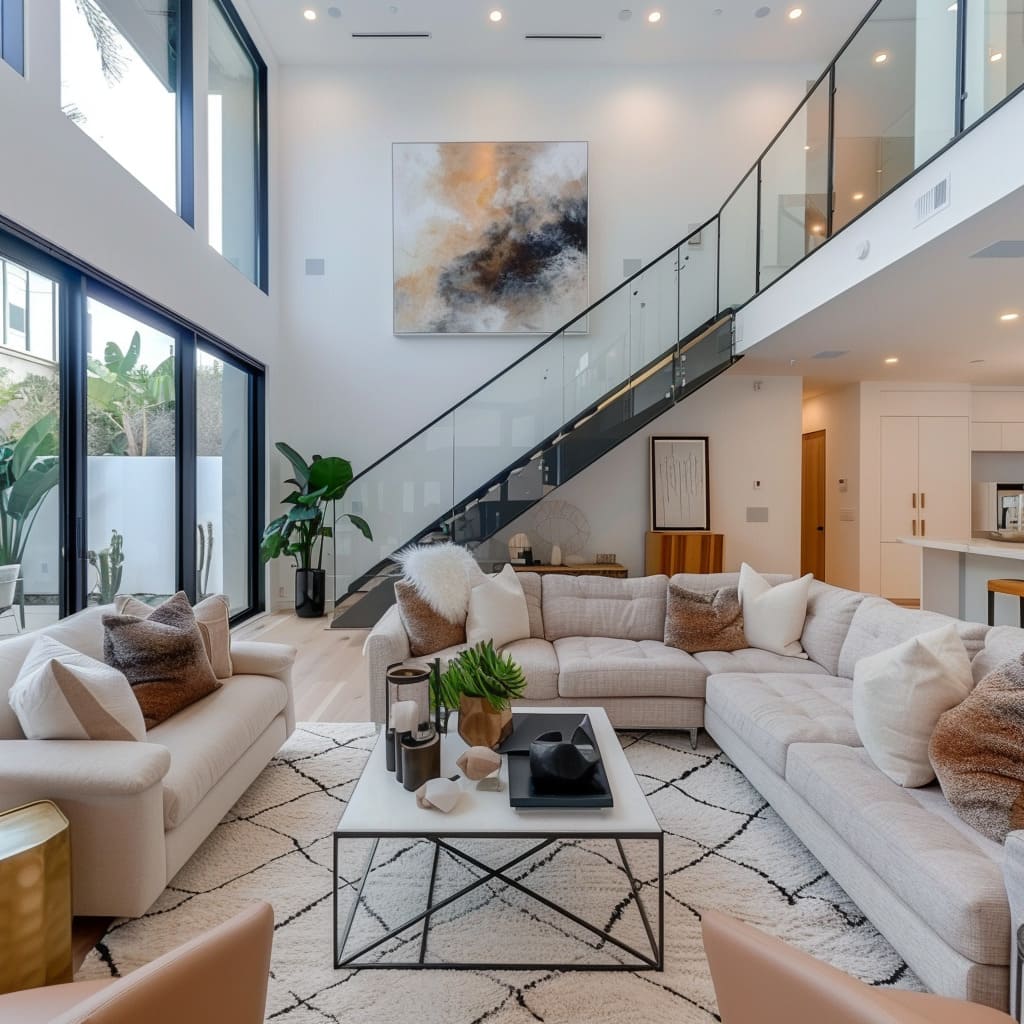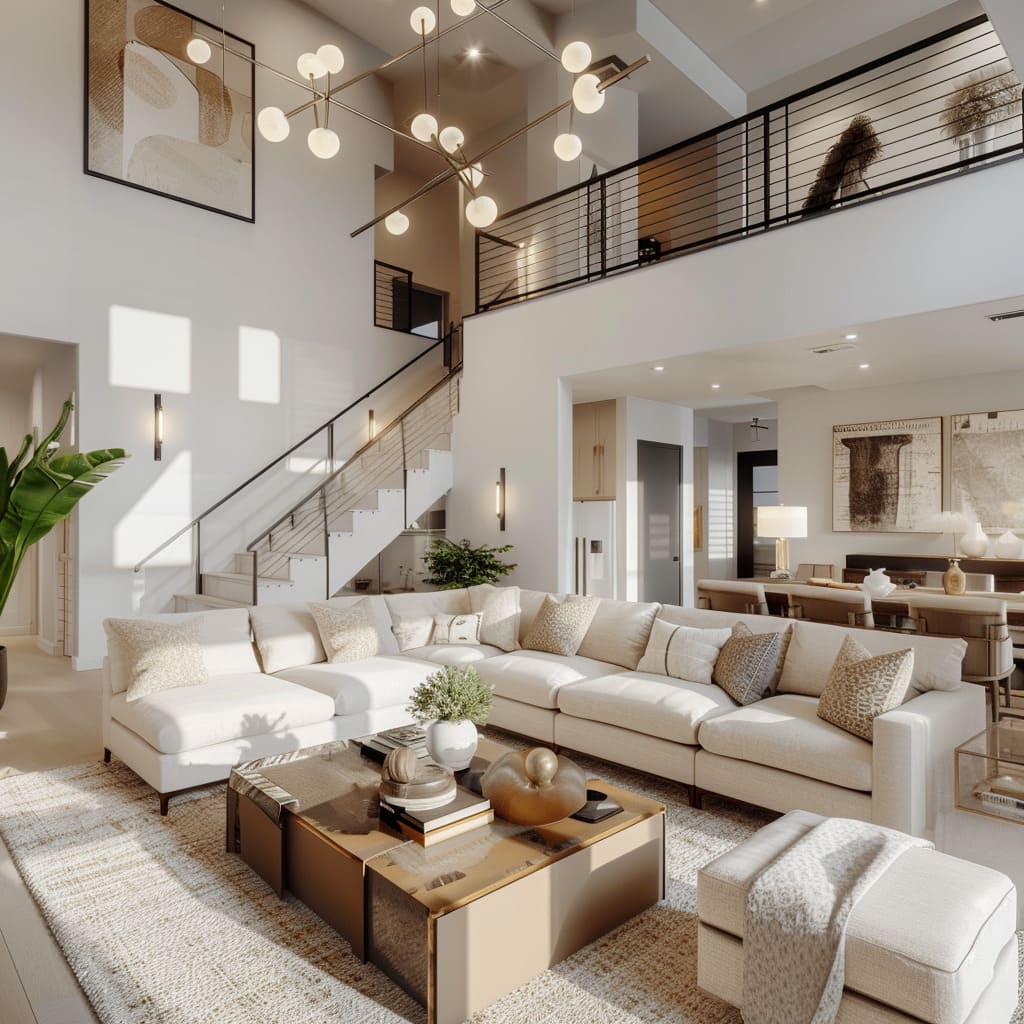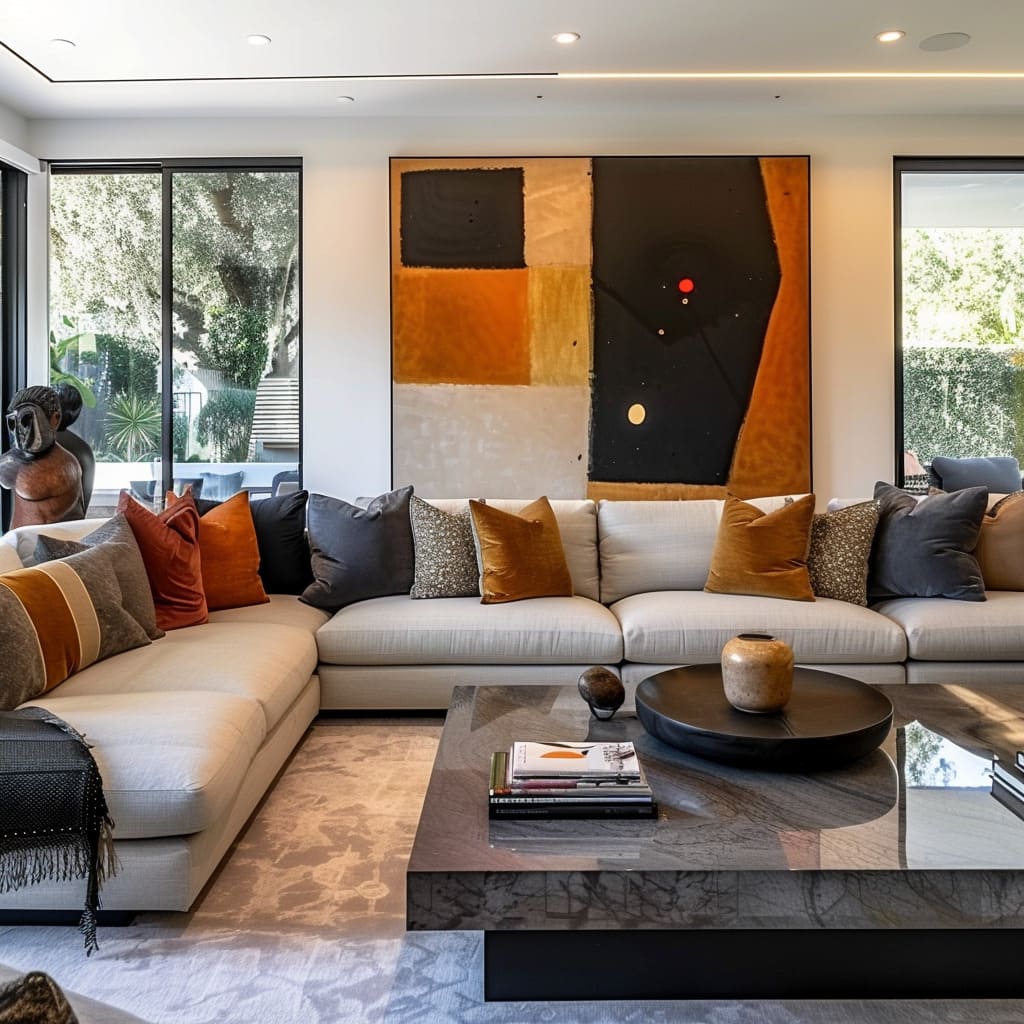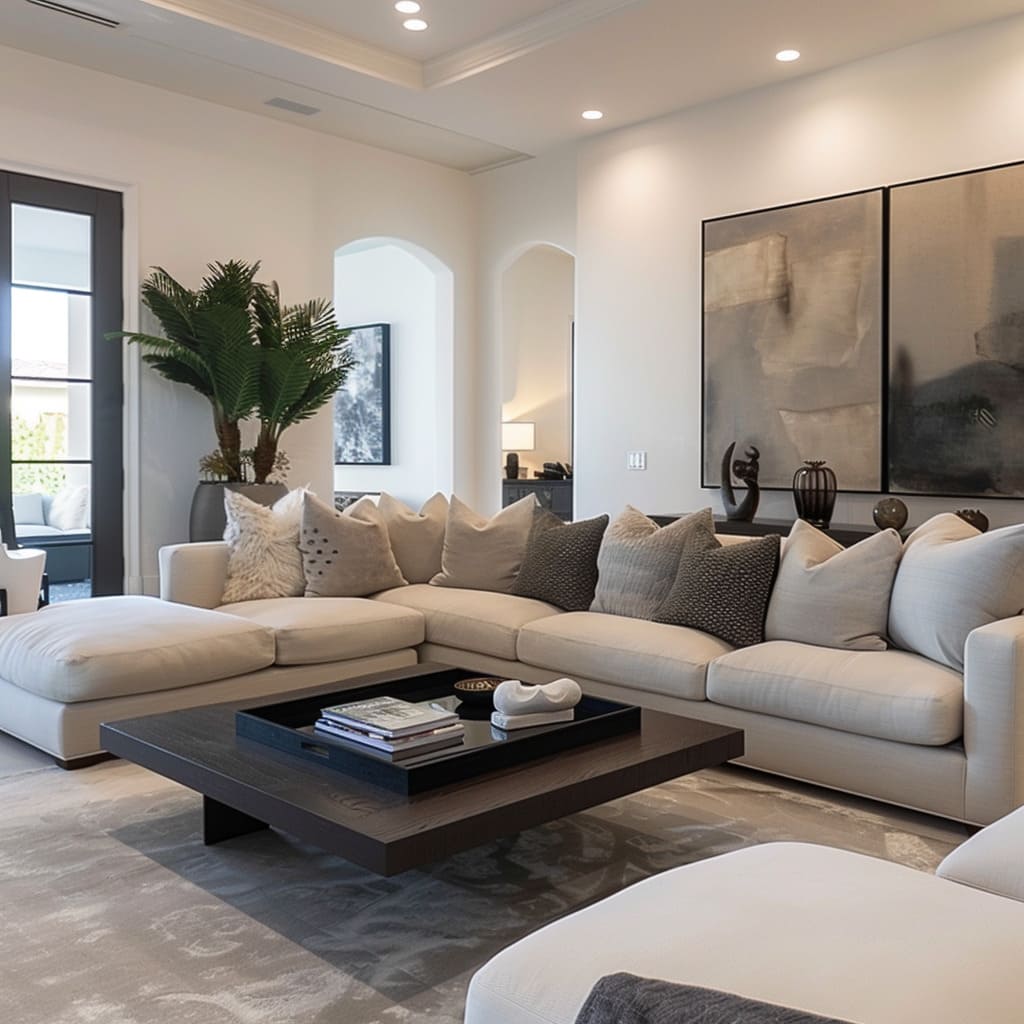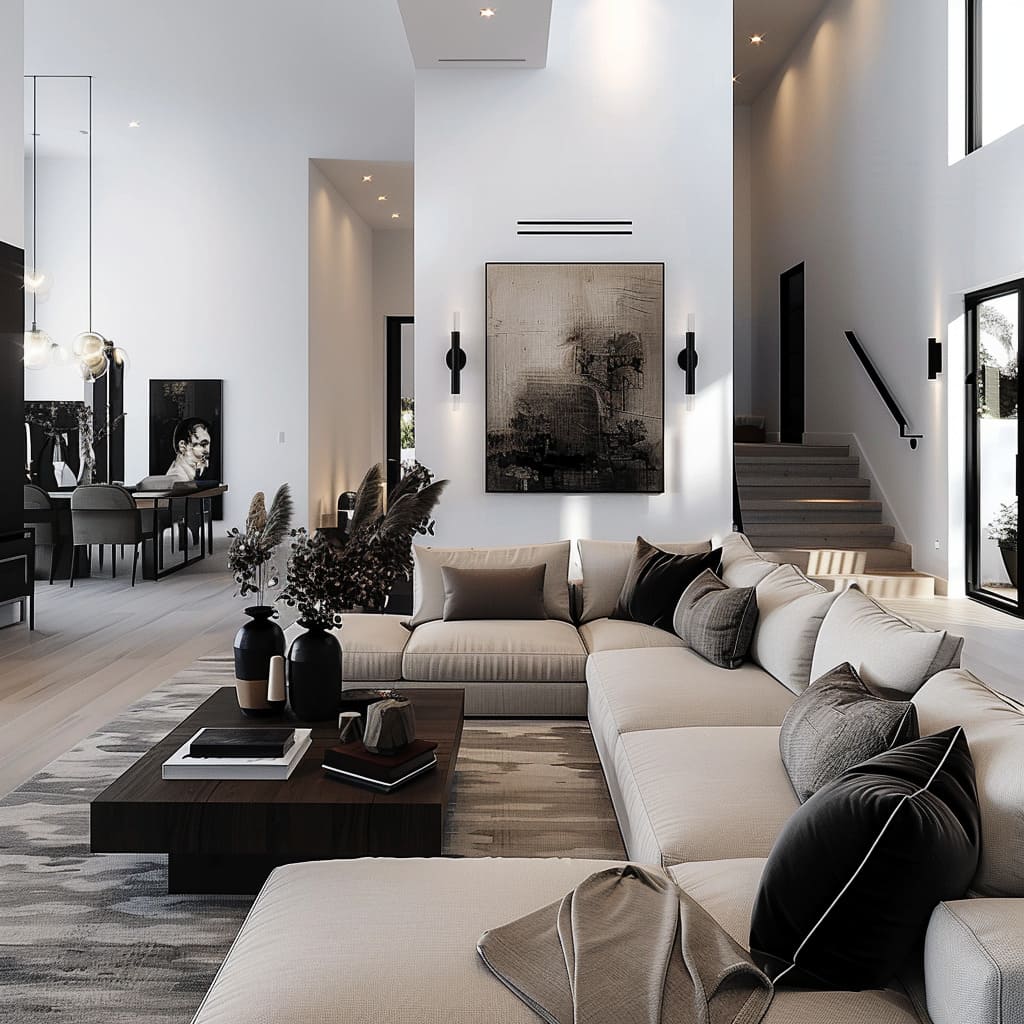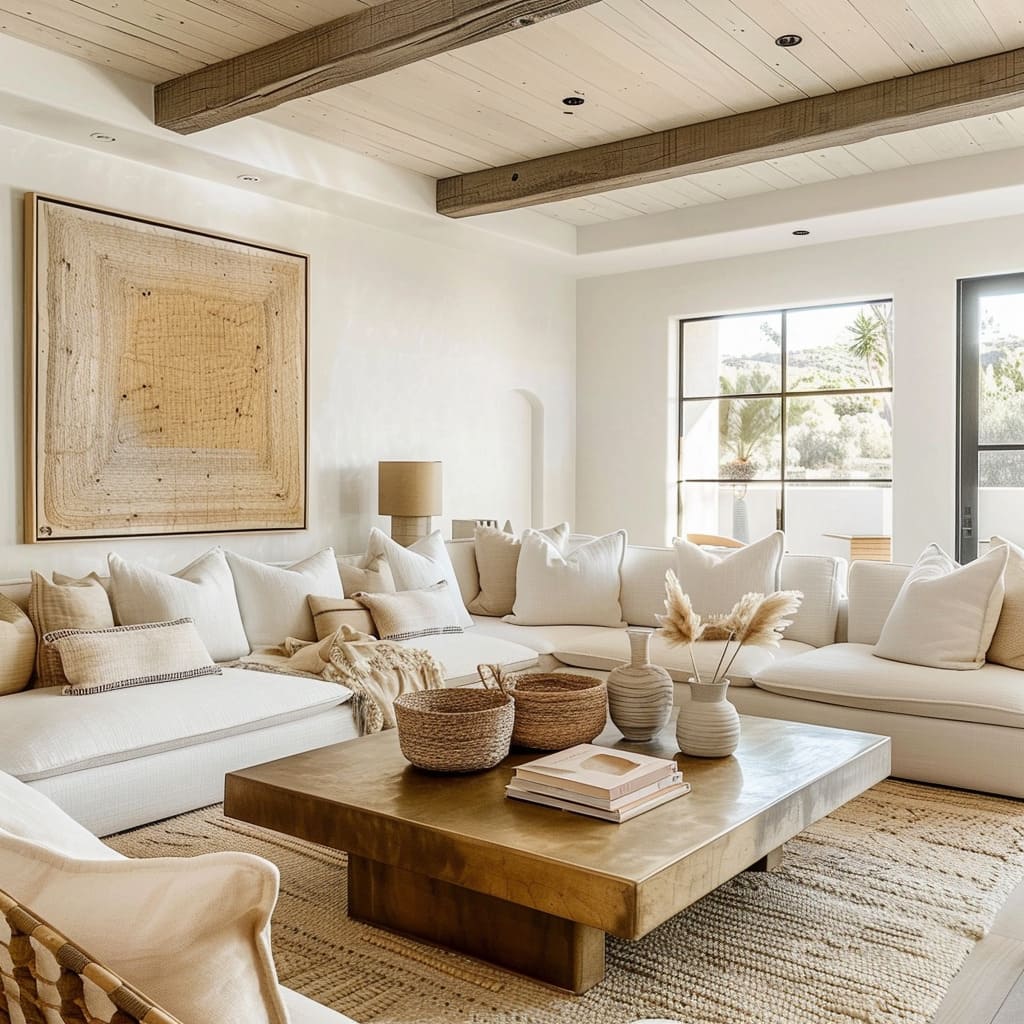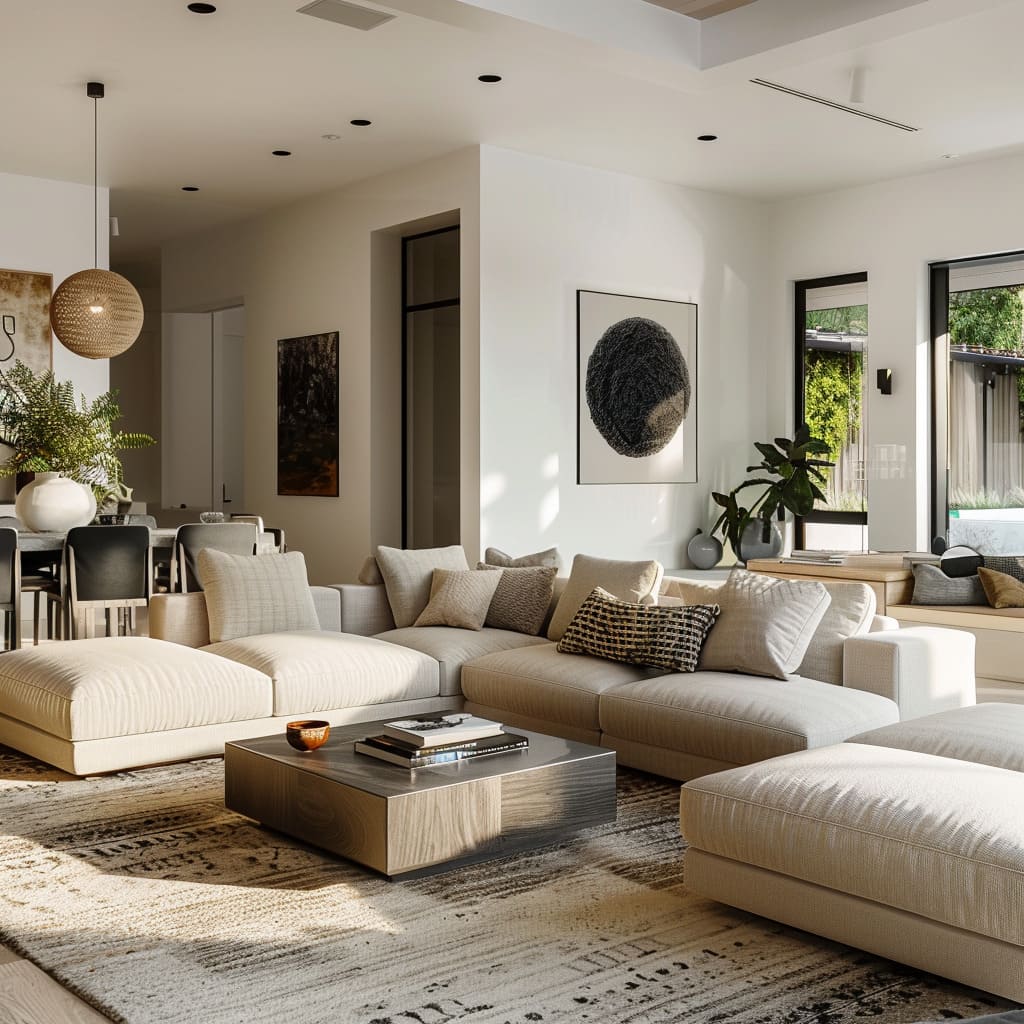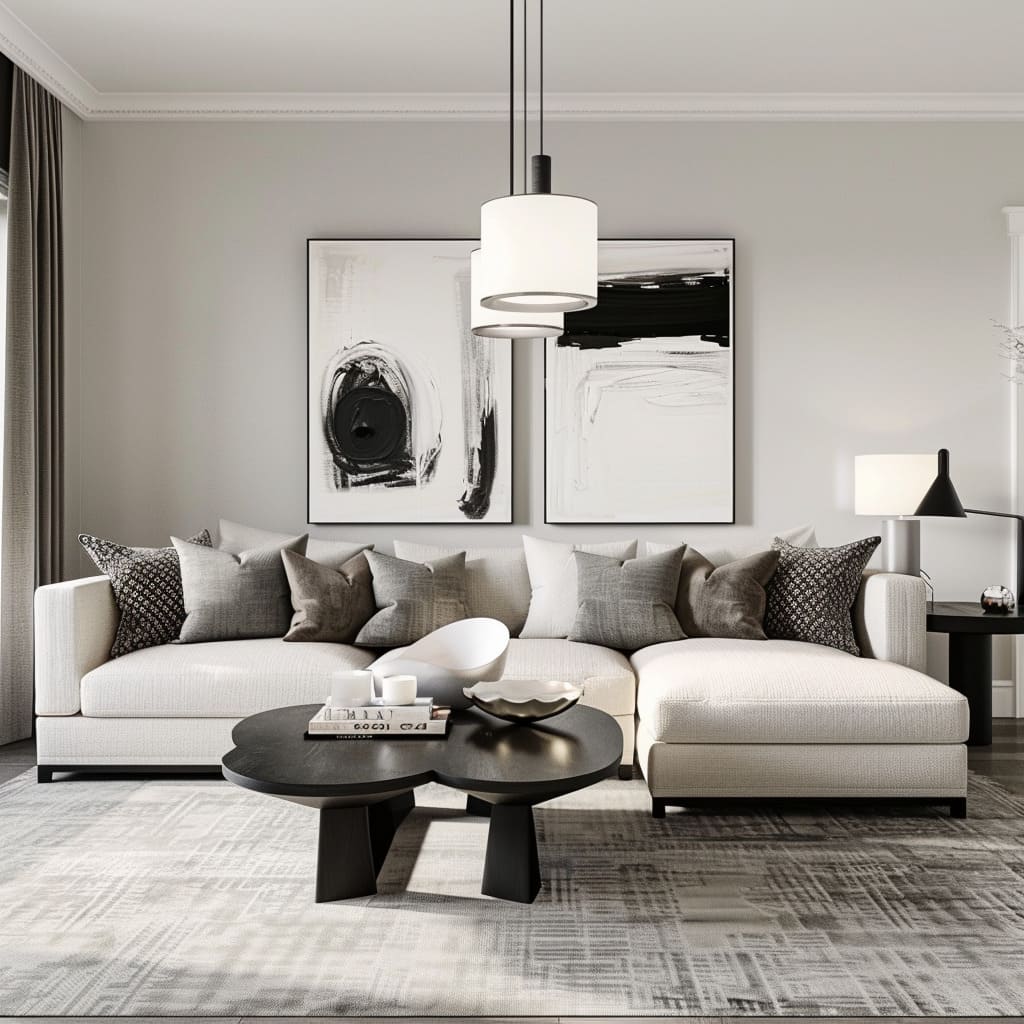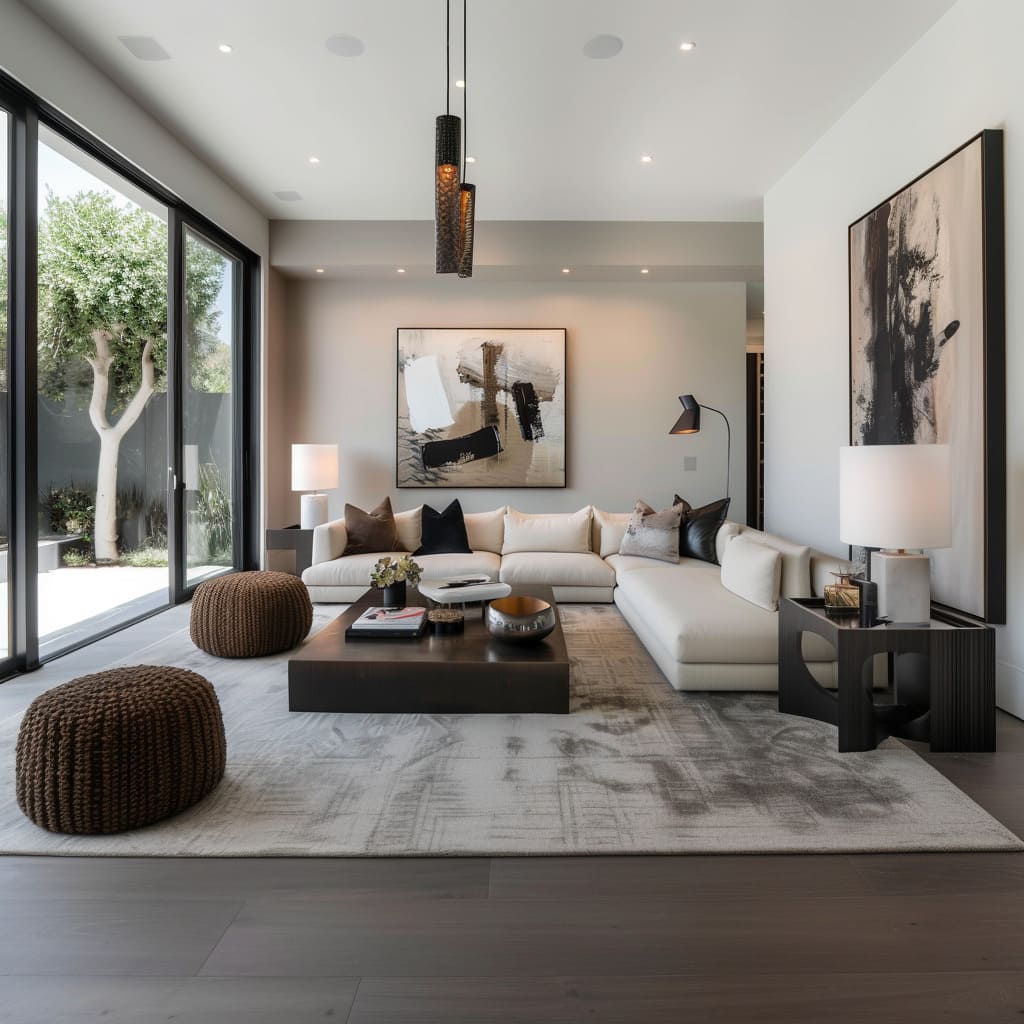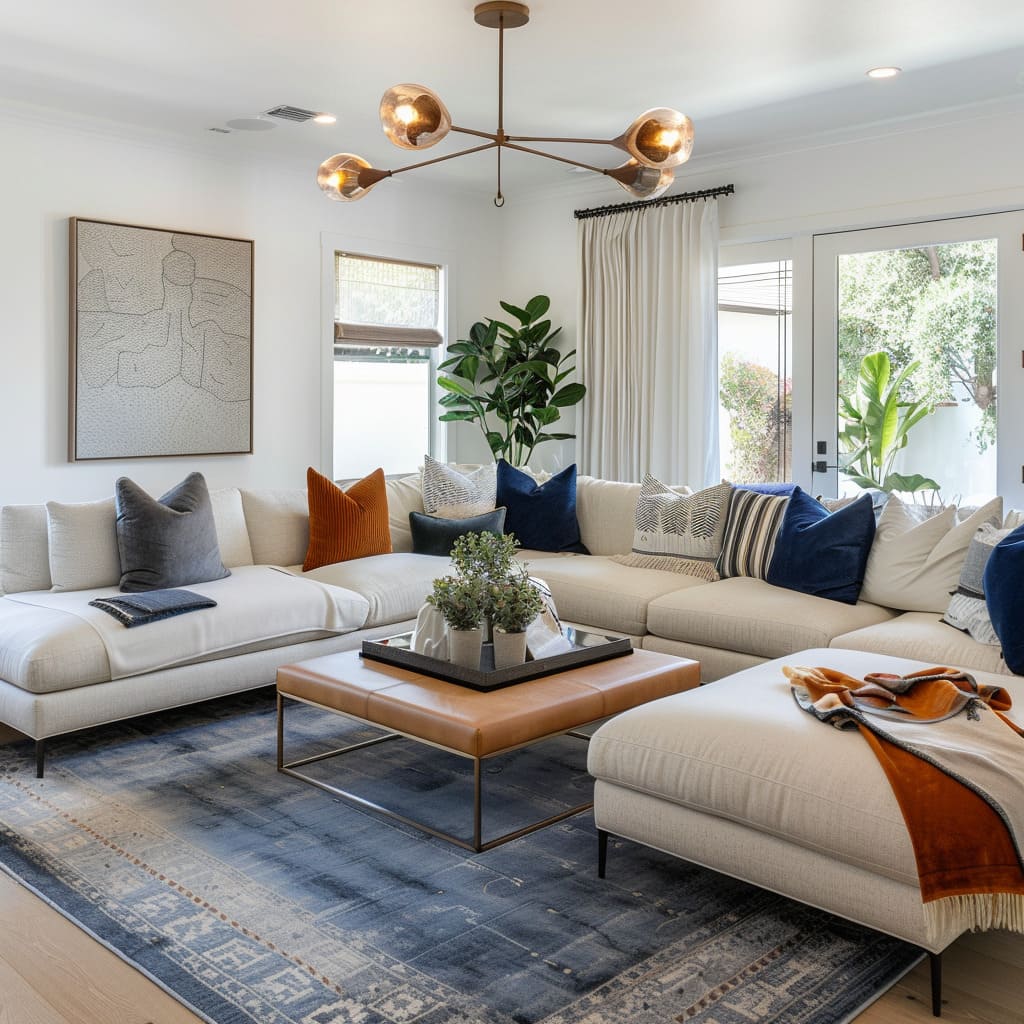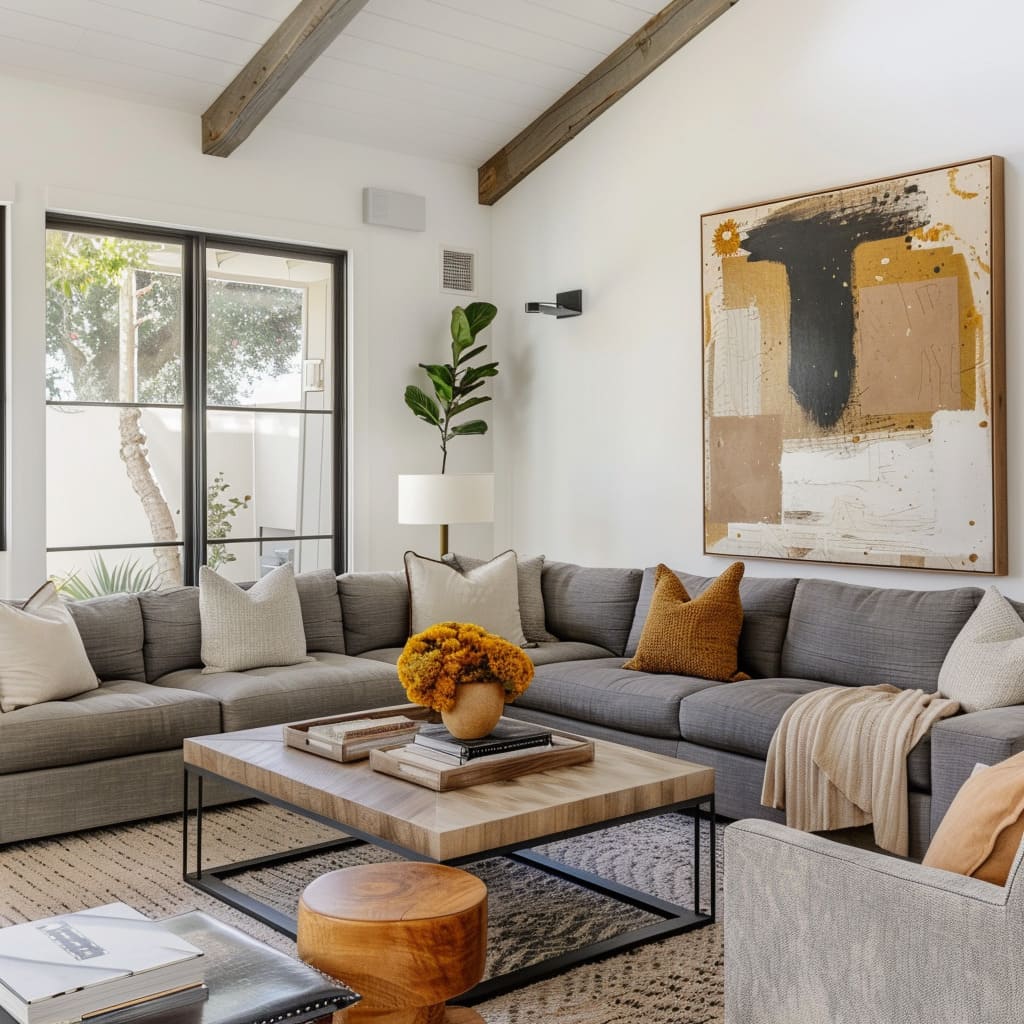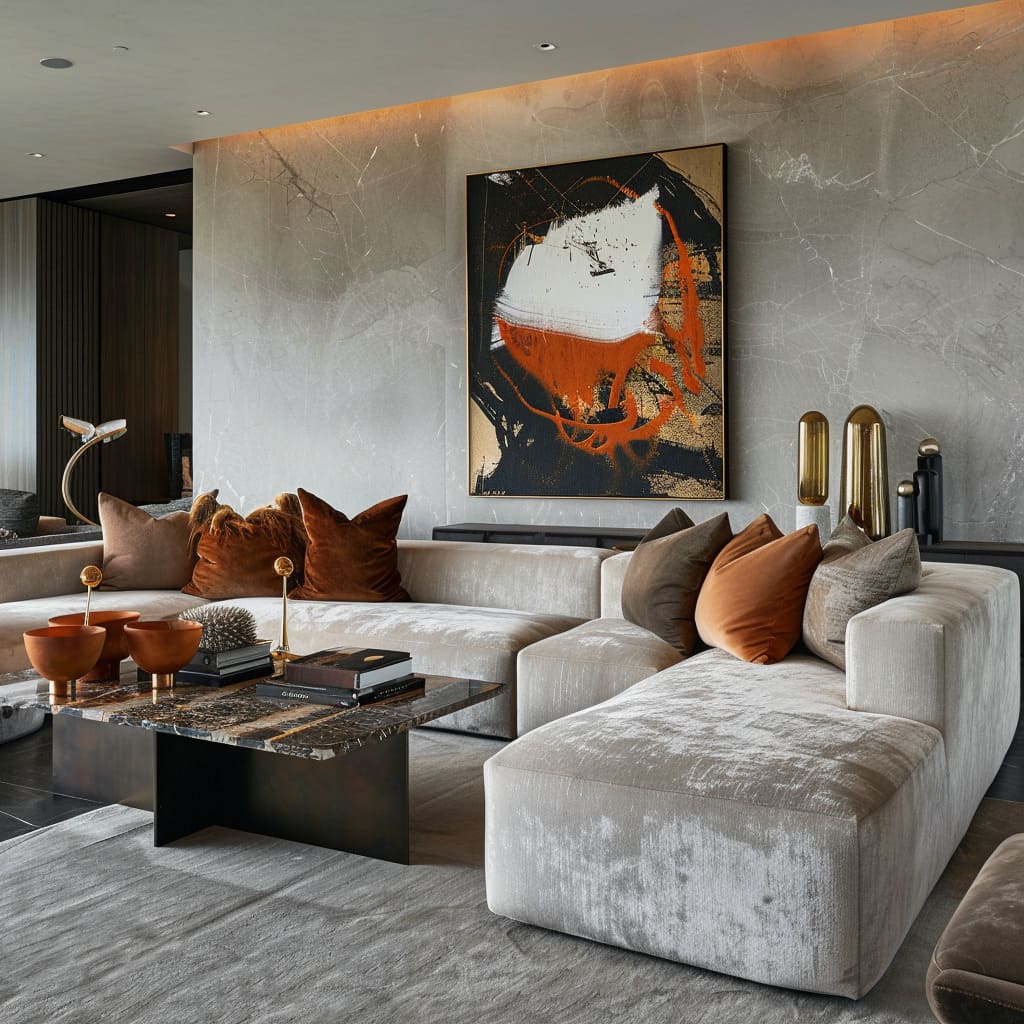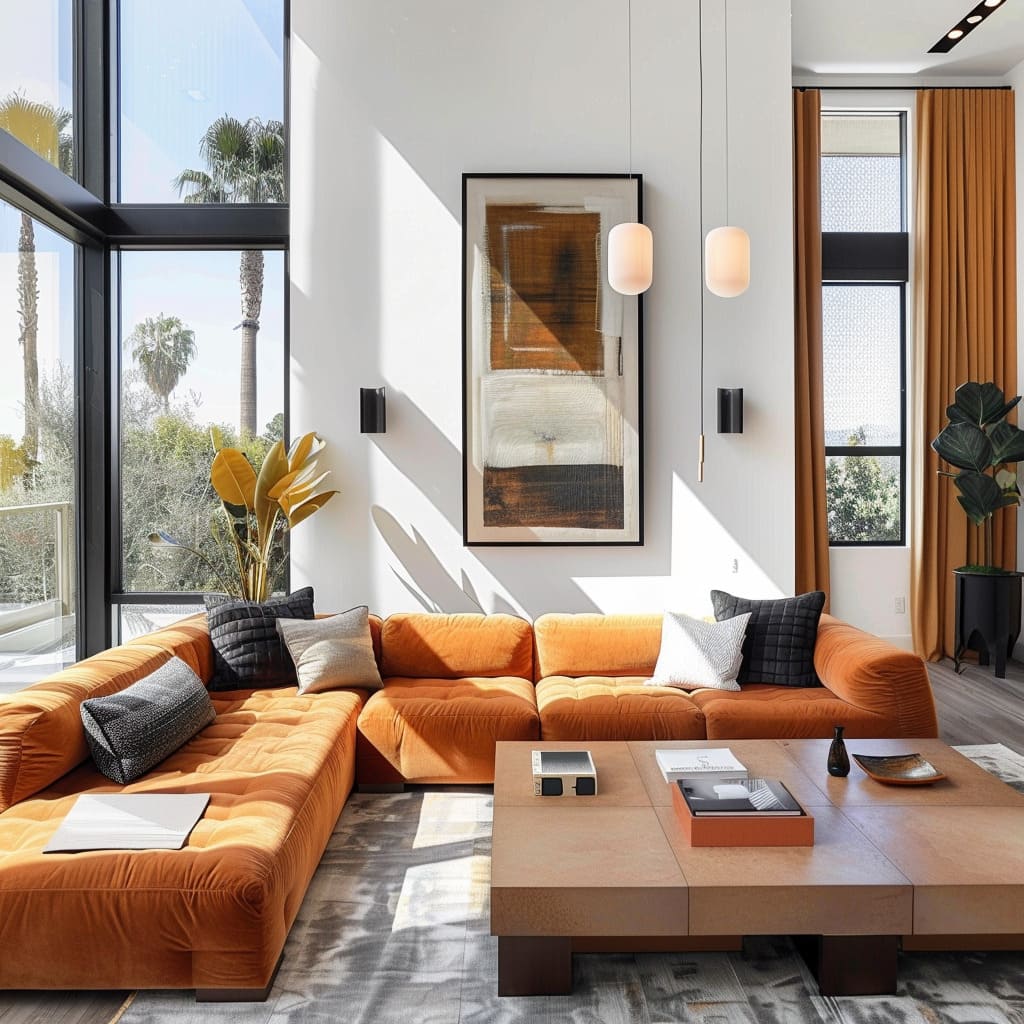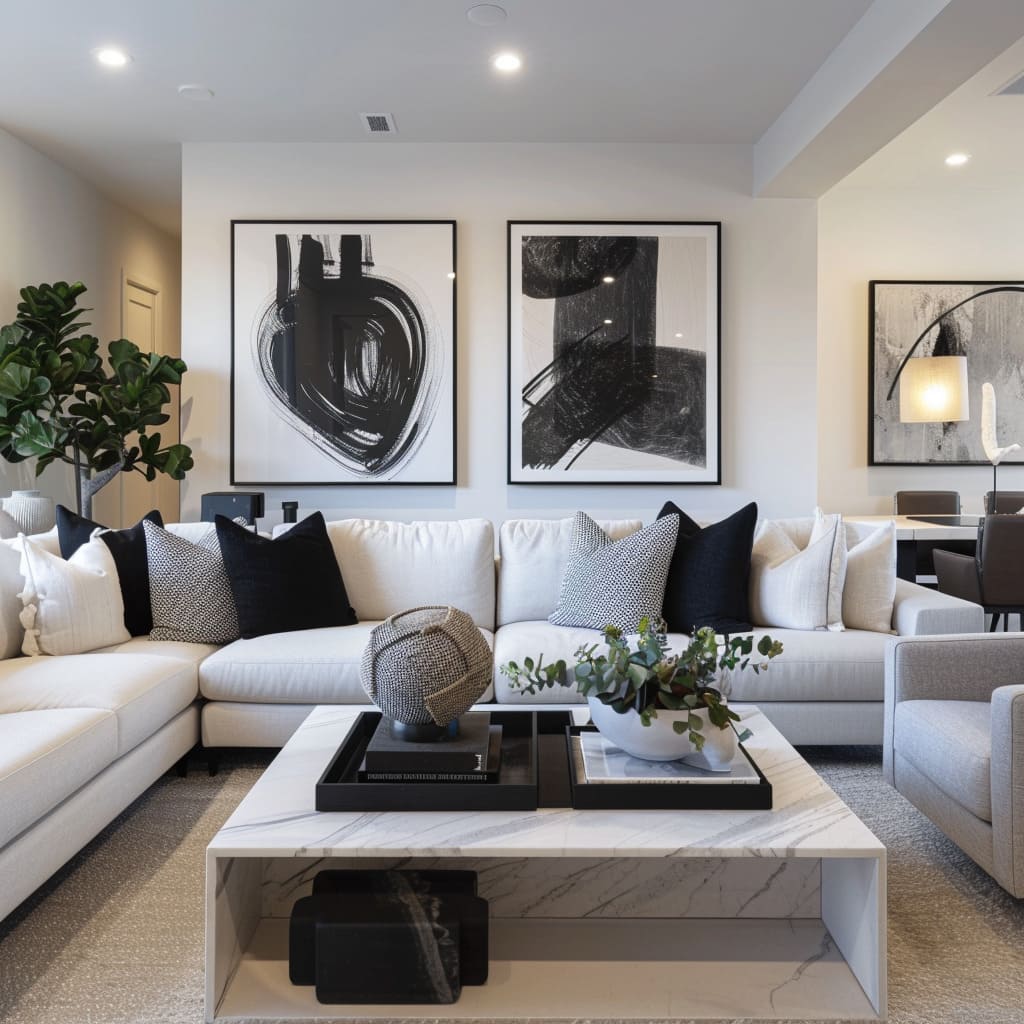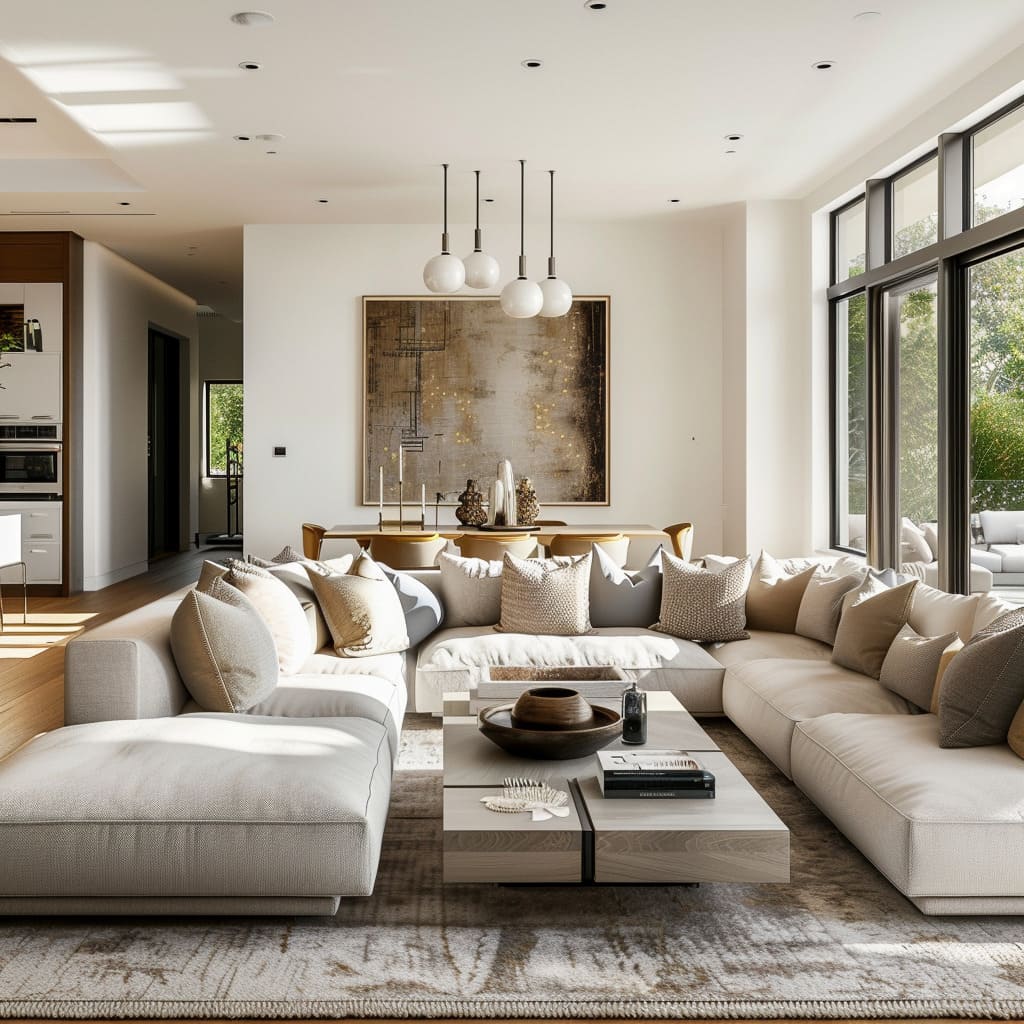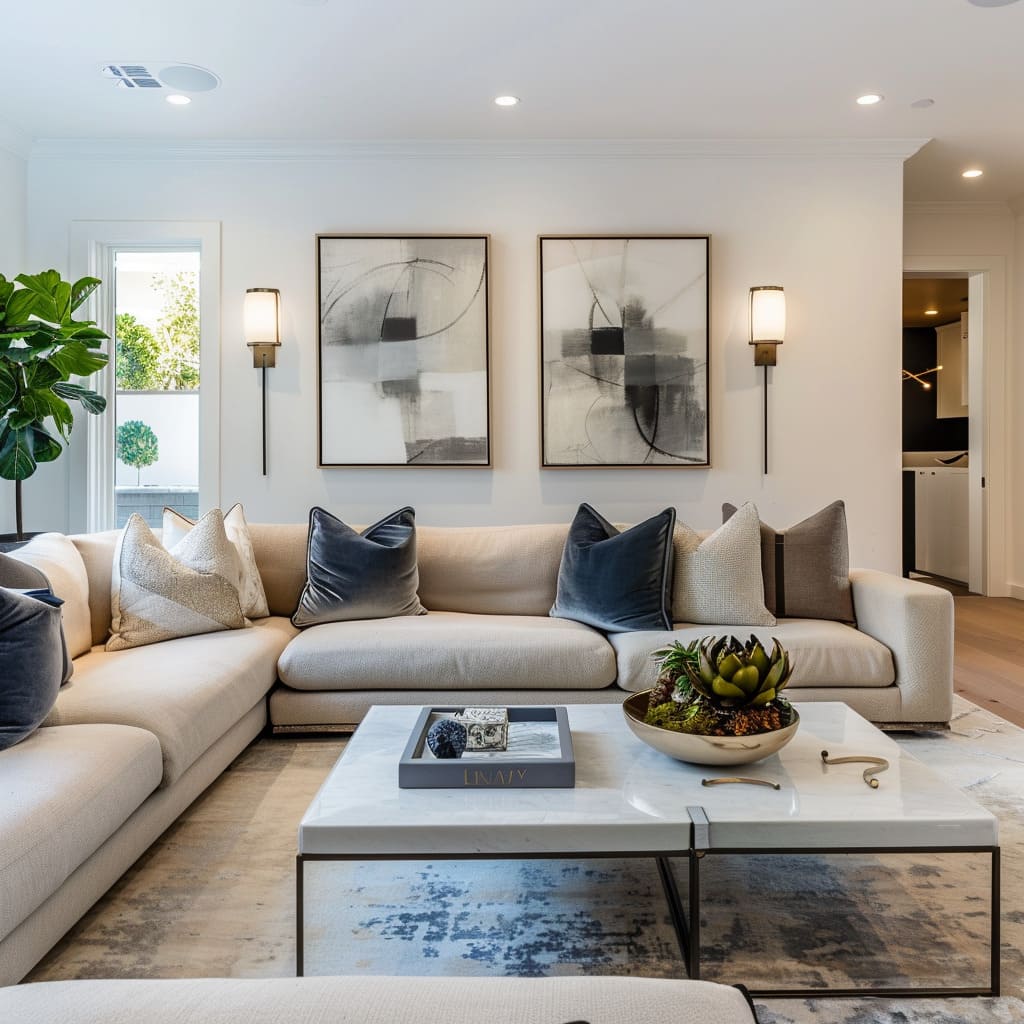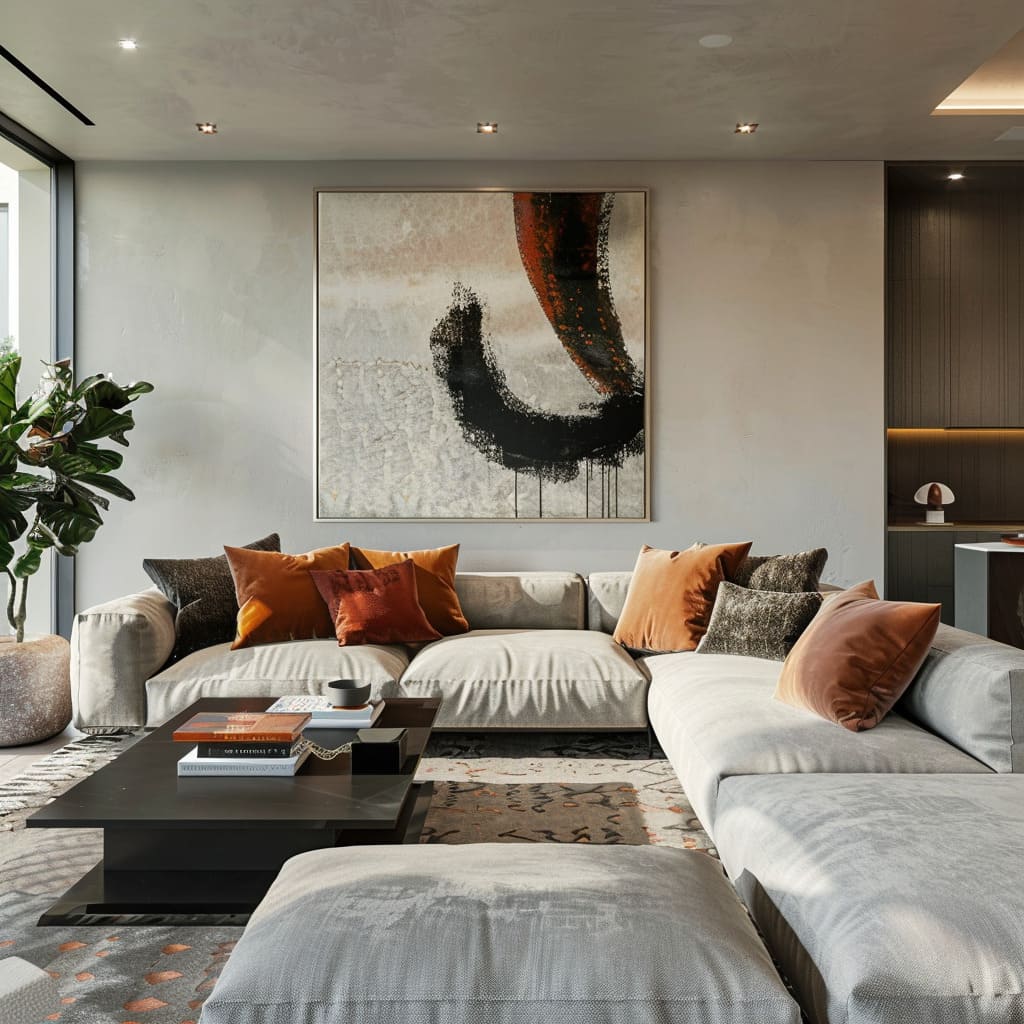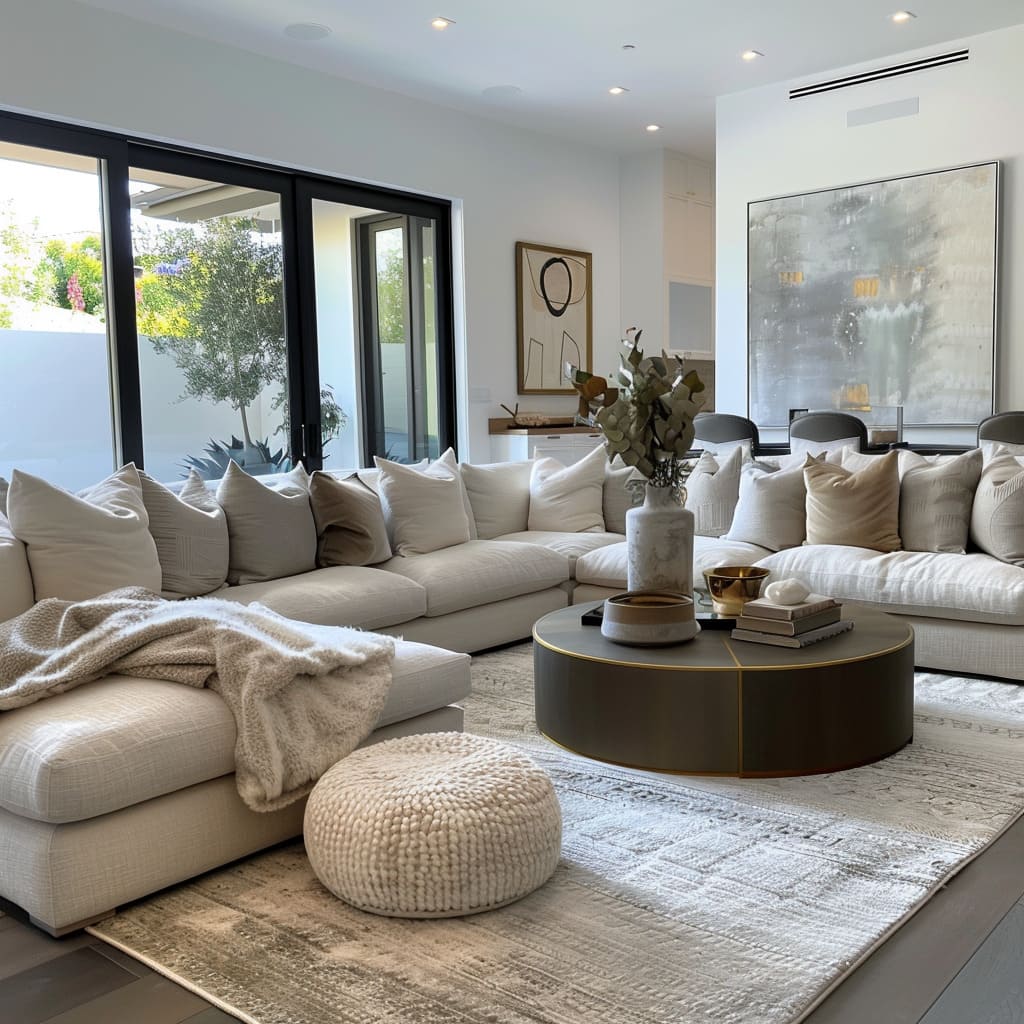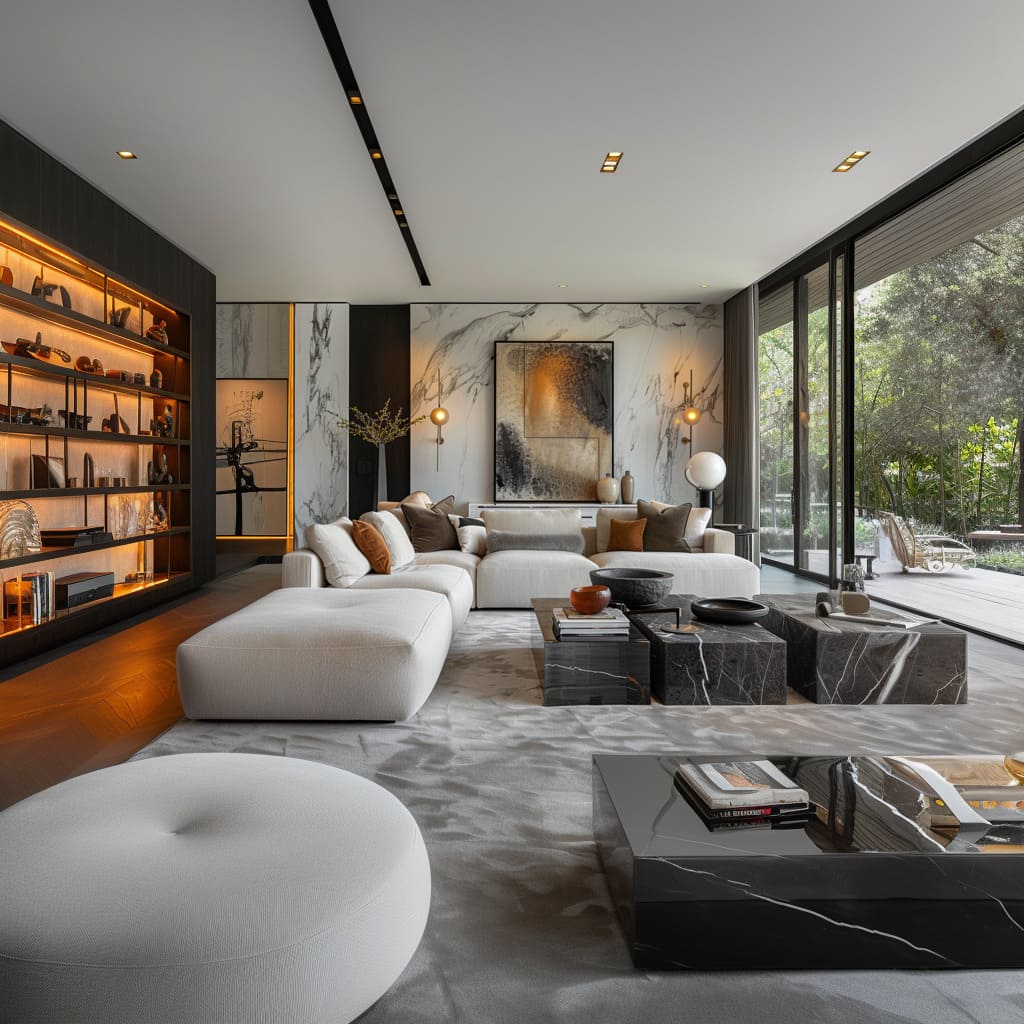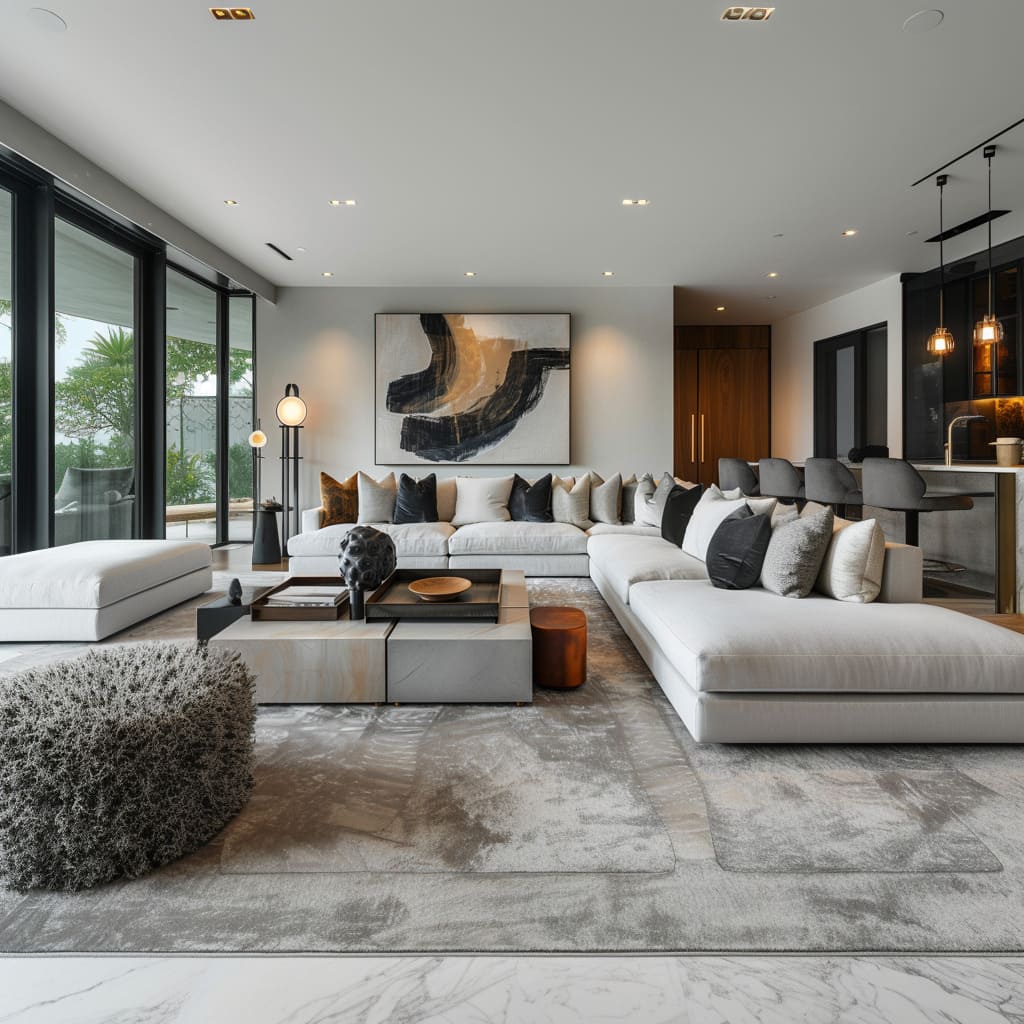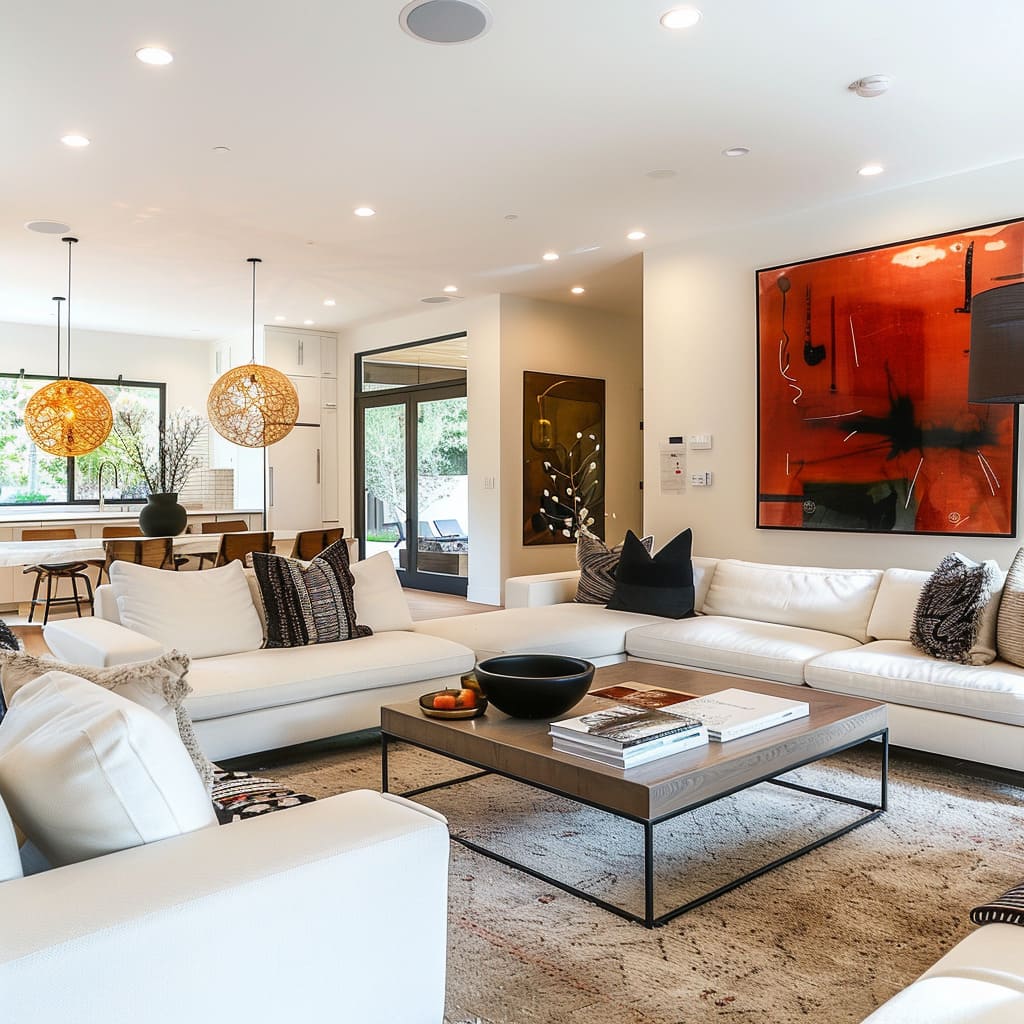In the fluid world of interior design, the spaces we inhabit become canvases for expression, functionality, and innovation. This article seeks to dissect the layers that compose such vibrant canvases, exploring the subtle interplay of form, the thoughtful orchestration of space, and the seamless melding of function with beauty.
As we delve into the nuances of modern interior styling, we uncover how each design element contributes to a home’s story, shaping environments that are as varied as the lives they frame. Join us as we traverse the various dimensions of design, from the tactile allure of textured surfaces to the bold statements of artistic features, each chosen not just for their aesthetic but for the lived experience they offer.
Visual Dynamics and Form
Theese characteristics examine the interplay of form and visual dynamics within interior spaces. This includes the Contrast Through Form, where contrasting shapes are paired together to create visual appeal, and Fluidity of Shapes, where the flow of organic forms offers a counterpoint to angular lines.
Dynamic Ceiling Treatments contribute to this group by altering perceptions of height and space, while Emphasis on Linearity introduces a structural rhythm through pronounced lines. Together, these characteristics shape the visual narrative of the interior.
Contrast Through Form
Within the realm of design, the interplay between varying shapes is a subtle method of drawing the eye. Consider the juxtaposition of rectangular coffee tables against curvaceous sofas, or the placement of round lighting fixtures above angular seating.
These contrasts create a dialogue within the room that speaks to both innovation and comfort, providing visual interest through shape rather than color. Angular architectural elements act in concert with more fluid forms, lending a sculptural air to the living spaces.
Fluidity of Shapes
Organic contours offer a respite from the geometrical precision of modern construction. In selecting furnishings with curves and undulations, designers inject a softness into the area, allowing for a visual breathing room.
These shapes mimic the ebb and flow found in nature, imparting a tranquil and welcoming atmosphere. The gentle arcs of armchairs or the wavy patterns on rugs introduce a sense of motion, inviting one to relax and enjoy the fluidity of the space.
Dynamic Ceiling Treatments
The ceiling often acts as the fifth wall in a room, offering an expansive canvas for creative expression. Unique ceiling treatments, like varying levels and recessed lighting, can transform the overhead space into a compelling component of the room’s overall composition.
High ceilings might be complemented with tall indoor foliage, emphasizing verticality, while layered lighting can accentuate textured surfaces above, adding depth and interest.
Emphasis on Linearity
Strong lines serve as the visual framework within a space, directing attention and drawing connections between different elements of the room. Whether it’s the length of a staircase railing or the extended edge of a long dining table, these lines provide a sense of order.
Shelving with clean, straight edges offers not just storage but also a graphical element that ties into the room’s overall design narrative, ensuring cohesion and continuity.
Composition and Spatial Experience
This section delves into the deliberate organization of space and objects to shape the user’s experience. Curated Spaces are thoughtfully arranged to evoke specific emotions or facilitate activities.
Manipulation of Volume plays with the dimensions of space, impacting how it feels to those within it. Serenity in Composition seeks to establish tranquil environments, focusing on the calming arrangement of the space.
Finally, Visual Connectivity ensures a harmonious visual flow, guiding the eye and fostering a cohesive experience.
Curated Spaces
In the consideration of a room’s purpose, every piece of furniture and decor is chosen with intention. Seats are arranged not just for conversation, but to encourage relaxation and interaction.
Careful selection of colors, materials, and even the space between objects can influence whether a space feels designated for productivity or for leisure. It’s the thoughtful assembly of these elements that transforms an area into a niche for reading, a communal gathering spot, or a peaceful retreat.
Manipulation of Volume
The grandeur of a room is often defined not by its size alone, but by the arrangement of its contents. Voluminous sofas may anchor a living space, while sparingly used accents avoid overcrowding the visual field.
The interplay of expansive floor plans with strategically placed furniture can amplify the perception of space, giving a liberating feel to the room. Varied ceiling heights can also orchestrate a rhythm within the home, from intimate alcoves to grand entryways.
Serenity in Composition
Harmony is achieved when the arrangement of furniture, the choice of decor, and the flow of movement within a space are in sync. A well-composed room takes into account the quiet symmetry of its layout, the soft touch of textiles, and the subdued tones of its palette.
It’s in these details that a sense of tranquility is woven, making for a sanctuary that feels removed from the outside world’s clamor.
Visual Connectivity
Sightlines play a crucial role in the perceived spaciousness and connectivity of an interior. The careful placement of furniture can guide the eye toward significant features or vistas, establishing an interconnectedness among separate zones.
This invisible grid of visual paths allows for an ease of movement and a comprehension of the space as a coherent whole, enhancing the user’s experience and sense of orientation within the home.
Functional Aesthetics and Adaptability
Here we explore how functionality merges with aesthetics in modern interior design. Adaptability in Furniture Design speaks to the growing demand for flexible living spaces, allowing pieces to be modified for various uses.
Zoning Through Rugs offers a way to define different areas within an open plan without the need for walls. Seamless Transitions highlight the ease of movement and coherence between different parts of a home.
The emphasis in this section is on practicality, ensuring spaces are not only beautiful but also highly adaptable to daily life.
Adaptability in Furniture Design
Flexibility is at the forefront of modern living. Seating that can be transformed or moved easily accommodates the shifting dynamics of today’s lifestyle.
Consider a modular sofa system that can be reoriented for a social gathering or an intimate family evening. Extendable tables, stackable chairs, and convertible desks also exemplify this adaptability, serving multiple purposes and evolving with the user’s requirements.
Zoning Through Rugs
Defining spaces within a larger area can be artfully achieved with the strategic placement of rugs. This technique not only demarcates different functional zones without the need for physical barriers but also adds layers of texture and warmth.
A plush rug can delineate a cozy reading nook in a corner of a room, while a flatweave design might underscore a dining area, subtly segregating it from a nearby lounge space.
Seamless Transitions
The artful blending of adjacent areas maintains aesthetic continuity while allowing each space to serve its unique purpose. Consistent flooring materials and a harmonious color scheme create an uninterrupted flow, making the transition from one area to the next almost imperceptible.
This not only enhances the sense of space but also promotes a cohesive living environment, where each area complements and is connected to the next.
Artistic Expression and Focal Points
This group encompasses elements that are deliberately integrated to command attention and express creativity. Oversized Artwork and Focal Point Creation are about making bold statements and anchoring the viewer’s attention.
Accentuation of Architectural Features showcases the inherent beauty of a building’s design, turning structural elements into art forms. These characteristics work together to create points of interest that punctuate the space, offering depth and character.
Oversized Artwork
The presence of large-scale art pieces acts as the heart of a room’s aesthetic, instantly drawing in the gaze. Such pieces are not merely decorative but play a vital role in setting the tone and atmosphere of the space.
Their scale allows them to stand out, making a bold statement that reflects the tastes and personalities of the inhabitants. These artworks often become the pivot around which the rest of the room’s design revolves.
Focal Point Creation
A thoughtfully designated focal point not only draws attention but also serves to visually organize a room. This could be a distinctively designed fireplace, a grand piano, or an intricately designed bookshelf.
These elements give a room its character and can be accentuated by strategic lighting or contrasting colors, ensuring they capture the eye and hold interest.
Accentuation of Architectural Features
Celebrating a building’s inherent beauty can be as simple as drawing attention to its structural details. Exposed beams, brickwork, or columns are treated as natural artwork, contributing to the room’s overall aesthetic.
Lighting can be used to highlight these features, casting shadows and creating depth, while complementary furniture can echo their lines and shapes, integrating them seamlessly into the design.
Visual Rhythm and Cohesion
By creating a sequence of focal points and harmonizing architectural details, a room develops a visual rhythm. This can guide the viewer’s gaze across the space, creating a sense of movement and cohesion.
Wall textures, ceiling patterns, or even floor inlays can serve as subtle focal points that contribute to this visual harmony, ensuring the space feels well-composed and thoughtfully designed.
Materiality and Textural Contrast
The final group looks at the tactile and material aspects of interior design. Variation in Surface Finishes offers a sensory experience through textural contrasts, while Material Innovation introduces new, often eco-friendly materials into the living space.
Selective Use of Color provides subtle emphasis without overwhelming the senses. Purposeful Asymmetry and Fusion of Design Movements reflect a thoughtful approach to material and stylistic choices, adding layers of complexity and intrigue.
These characteristics highlight the importance of material choice and placement in crafting a space’s feel and functionality.
Variation in Surface Finishes
The interaction between varied surface finishes can enhance the sensory experience of a space. From the soft glow of a satin-finished sideboard to the sleek reflection of a high-gloss table top, the interplay of textures adds depth and complexity.
Walls with a hint of texture contrast with smooth, polished floors, creating an engaging tactile landscape that invites touch and close inspection.
Material Innovation
Embracing the new and technologically advanced materials not only brings an edge to design but also showcases a commitment to sustainability. Recycled composites, bio-based plastics, and repurposed woods are finding their way into chic interiors, offering both durability and eco-conscious appeal.
These materials can be seen in countertops, flooring, and innovative furniture pieces, bridging the gap between forward-thinking design and environmental stewardship.
Selective Use of Color
In a predominantly neutral scheme, the judicious application of color can enliven a space without overwhelming it. A splash of ochre on a throw pillow, a deep blue vase, or a collection of terracotta pots can draw the eye and provide a pleasing break in the monochromatic theme.
These color pops are not random but are chosen for their ability to harmonize with the surrounding hues and textures.
Purposeful Asymmetry
There’s a calculated charm in the use of asymmetry, where the unexpected placement of artworks, off-center light fixtures, or an eclectic mix of chairs adds a dynamic quality. This deliberate imbalance forces the eye to move around the room, engaging the observer and making the space more memorable.
Fusion of Design Movements
Integrating diverse design philosophies can yield a space that is both refined and comfortable. A mid-century modern chair might sit comfortably beside a rustic wooden coffee table, while industrial lighting fixtures illuminate a classic herringbone floor.
This fusion creates a layered and lived-in look, giving the impression of a space curated over time with great affection and consideration.
Through this exploration of interior design’s multifaceted nature, we find that the true essence of a space lies in the confluence of its design elements. From the strategic placement of an oversized painting to the innovative use of sustainable materials, every choice is deliberate, contributing to a holistic narrative.
The dynamics of form, the tranquility of composition, and the interactivity of adaptive design all play integral roles in creating interiors that are not merely spaces but experiences. As the door closes on our immersive foray into the art of interior design, it is clear that the mastery of this craft lies in creating harmony between myriad elements, each resonating with the stories and rhythms of human life.


